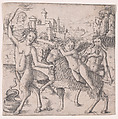Cupid riding a goat accompanied by two satyrs, landscape in the background
Circle of Giovanni Pietro da Birago Italian
Possibly by Giovanni Antonio da Brescia Italian
Not on view
The print is northern Italian and was likely made at the beginning of the sixteenth century. Elements of the design correspond to prints by Giovanni Pietro da Birago (formerly known as the Master of the Sforza Hours), but the execution is closer to certain works of his colleague and collaborator Giovanni Antonio da Brescia (previously also referred to as Zoan Andrea). The composition reverses another contemporary engraving with only minor changes (Hind 19). We cannot be certain which version came first. The subject possibly represents an allegory of lust, but like so many early Italian prints, the subject is never entirely transparent. The central group of the cupid on a goat was likely derived from an artwork dating back to Antiquity. It is quoted, with variations, in other sixteenth century prints and drawings. Prints of this kind were made for an erudite audience who would have appreciated witty and engaging subjects. The engraving is known in only one other impression in the Bibliothèque nationale de France in Paris.
This image cannot be enlarged, viewed at full screen, or downloaded.


